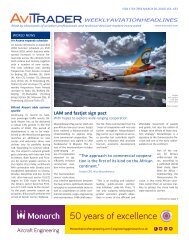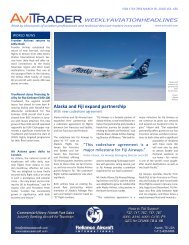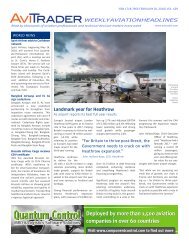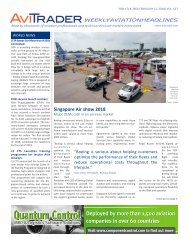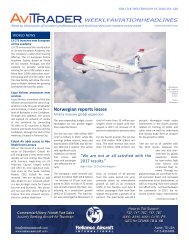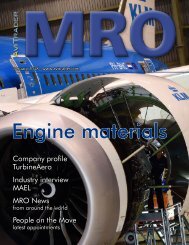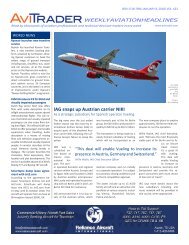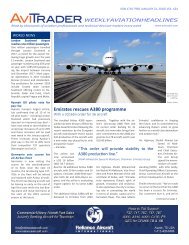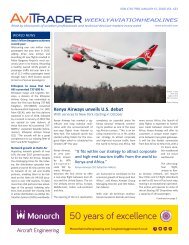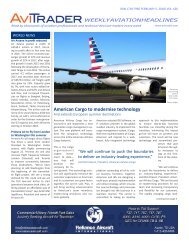You also want an ePaper? Increase the reach of your titles
YUMPU automatically turns print PDFs into web optimized ePapers that Google loves.
Machining productivity<br />
26<br />
To accomplish this, retention knobs are used. However, Ausbun says<br />
that newer CNC milling machines exert significantly more drawbar<br />
pressure on the knobs than in the past. This is compounded by the<br />
fact that most retention knob manufacturers provide little information<br />
on the proper torque required, a factor that can lead to the improper<br />
seating already described above.<br />
As a result, Ausbun says several of the retention knobs literally pulled<br />
apart during operations.<br />
“As drawbar tension continues to increase in CNC machines, it puts so<br />
much pressure on the weakest link, the retention knob, that it’s bound<br />
to come apart,” says Ausbun.<br />
“It’s a significant issue because if the retention knob comes apart while<br />
the machine is running it could cause considerable damage,” adds<br />
Ausbun. “You are talking spindles that cost $10-$14 thousand a piece<br />
today, not to mention the downtime. That’s a lot of money.”<br />
High Torque retention knobs<br />
To find a solution, Ausbun did some online research and found JM Performance<br />
Products, Inc. (JMPP). In 2009, the company introduced its<br />
High Torque retention knob. Invented by the company’s founder, John<br />
Stoneback, the product works with all existing toolholders including BT,<br />
DIN, ISO, and CAT toolholders from 30 taper to 60 taper.<br />
The High Torque retention knob is longer by design to reach deeper<br />
into the threaded bore of the toolholder. As a result, all thread engagement<br />
occurs in a region of the toolholder where there is a thicker<br />
cross-section of material to resist deformation.<br />
It also includes a precision pilot to increase rigidity, and is balanced by<br />
design. Since even over-tightening of the High Torque retention knobs<br />
can still create a bulge, the company provides specifically calculated<br />
torque specs based on drawbar pressure.<br />
By combining the High Torque retention knob with the correct torque,<br />
spindle contact with the taper is improved to close to 100% every time.<br />
After finding out more information about the product, Ausbun says he<br />
decided to order a few and give them a try. In addition to having high<br />
hopes for the product, he says he was also impressed that JMPP had<br />
researched the appropriate torque settings for installing the retention<br />
knobs as well.<br />
“When you start checking out different manufacturers as to what they<br />
recommend for torque specs on the retention knobs, everyone seems<br />
to have a different opinion,” says Ausbun. “I thought it was pretty impressive<br />
that [JMPP] went the extra mile and put a lot of research into<br />
determining the ideal torque.”<br />
Tool life<br />
By increasing the rigidity of the toolholder at higher RPMs, the High<br />
Torque retention knob can also increase tool life.<br />
Retention knob installed in toolholder.<br />
“In aerospace every shop is trying to machine parts faster and aggressively<br />
remove more stock, just to stay competitive,” says Ausbun. “This<br />
just puts more pressure on the tool.”<br />
With higher-end technical carbide inserts, the cost of tool replacement,<br />
not to mention loss of production time due to frequent changeover, can<br />
add up quickly.<br />
“Since we changed to the High Torque Retention Knobs, we are not<br />
going through inserts like we used to and we haven’t had any more<br />
issues with retention knobs pulling apart,” says Ausbun. “I’m also not<br />
seeing any distortion in the toolholder taper either.”<br />
Ausbun estimates that tool costs have been reduced by as much as<br />
20% as a result.<br />
Although manufacturers are already benefitting from implementing the<br />
High Torque retention knobs, others remain unaware – even dismissive<br />
– that improper seating of tapered toolholders is even a problem.<br />
Perhaps more than some other industries, aerospace manufacturing<br />
can take a toll on the carbide cutting tools used when machining exotic<br />
alloys and hard metals. The result is that cutting tools must be<br />
changed out more frequently as they dull or break.<br />
<strong>AviTrader</strong> <strong>MRO</strong> - November <strong>2017</strong>





